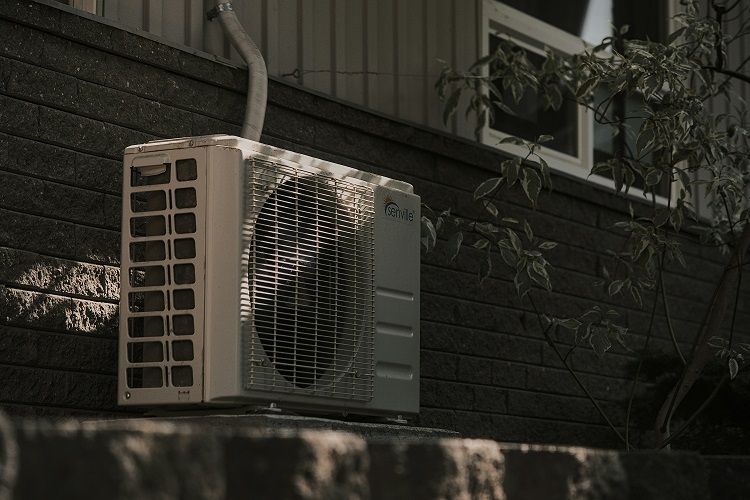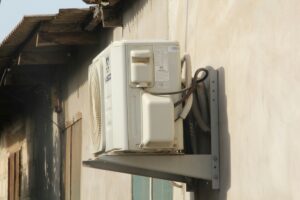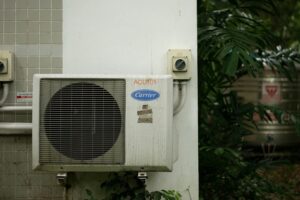Types of air conditioners
Before installing an air conditioner is necessary to know what types exist and which is the most suitable for our home. Currently there are a variety of devices to choose from depending on whether we need it for a home or for a local:
Air conditioners for homes
Split air conditioners
It is the easiest type of air conditioner to install. In addition, the price of installing this air conditioning system is the most economical. Therefore, it is the most used today.
Split air conditioning takes its name from the English (split = divide), since it is a system divided into two parts: a unit that is placed inside the house and an external one that is usually installed on the facade.
The lower part is the one that absorbs the hot air from the room to cool it, while the outdoor unit is the one that expels hot air to the street.
Within the splits, we can talk about two types according to their size: normal length devices and small air conditioning models for small rooms. If you want to know how much air conditioning power a small room needs, we show you how to calculate how many frigories per m2 you need.
Multisplit Air Conditioner
The multi split air conditioner works the same as the split air conditioner, but this has several indoor units distributed in different rooms and a single outdoor unit. It can be a 2×1 (double split), 3×1 and even 5×1 air conditioners.
This air conditioning system is often used in homes where, in addition to the living room you want to air condition some of the rooms. The advantage of this system is that noise is reduced, since only one compressor is needed for several splits.
Ducted air conditioning
The ducted air conditioning only needs an outdoor unit that performs the whole process and directs the cold air to the different rooms through a false ceiling where the ducts go. At the end of each duct there are grilles through which the air exits at low temperature.
The fact that you have to install a false ceiling and ducts make it necessary to perform a work, so this air conditioning system is more suitable for renovations or new homes.
Fancoil air conditioning
Fancoils are air-to-water air conditioning systems that have a heat exchanger, a fan and a filter. Water, hot or cold, is delivered to these components from a generator such as a gas boiler or an aerothermal system.
When the water reaches the unit, the heat exchanger transfers the cold to the surrounding air and then expels it to the room environment by means of a fan.
Portable air conditioner
It works just like a regular air conditioner, but it has only one indoor unit instead of having one outdoor and one indoor unit.
The good thing about the portable air conditioner is that it is not necessary to make a hole in the wall to connect both units as in the split air conditioner. But you do need a tube that is attached to a window to take the hot air outside. However, it has both advantages and disadvantages. This makes its installation is much simpler.
- It is the only air conditioner without professional installation.
Solar air conditioners
One of the best air conditioners is what is known as solar air conditioning. This air conditioning system draws energy from an array of solar panels. This allows bills to be reduced considerably and clean, renewable energy to be used. The only downside is the high initial investment, as it is not exactly economic equipment.
This is not the only equipment that works thanks to renewable energy, as there is also the aerothermal air conditioning. However, you should keep in mind that the price of aerothermal and solar energy are somewhat high.
Split Casette Air Conditioner
The cassette air conditioner is a split air conditioning system, whose indoor unit is installed on the ceiling. It has a large size and power, so it distributes the air much better and covers larger surfaces.
It is usually installed in false ceilings, leaving only the console that distributes the air through its four outlets, from top to bottom. It is perfect for premises and offices and, although they can also be installed in homes, they are much less used in the domestic environment.
Aire acondicionado split de cassette
El aire acondicionado cassette es un sistema de aire acondicionado split, cuya unidad interior se instala en el techo. Tiene un gran tamaño y potencia, por lo que distribuye mucho mejor el aire y cubre mayores superficies.
Suele instalarse en falsos techos, dejando sólo la consola que distribuye el aire por sus cuatro salidas, de arriba abajo. Es perfecto para locales y oficinas y, aunque también se pueden instalar en viviendas, son mucho menos utilizados en el ámbito doméstico.
Cassette split air conditioner
The cassette air conditioner is a split air conditioning system, whose indoor unit is installed on the ceiling. It has a large size and power, so it distributes air much better and covers larger surfaces.
It is usually installed in false ceilings, leaving only the console that distributes the air through its four outlets, from top to bottom. It is perfect for premises and offices and, although they can also be installed in homes, they are much less used in the domestic environment.
VRV air conditioner
The VRV air conditioner has a large outdoor unit and several indoor units. The particularity of this system is that the amount of refrigerant supplied can be regulated, hence its name Variable Refrigerant Volume (VRV).
They have high power, so they are often used in shopping malls. Two-pipe VRV systems can generate cooling or heating, but not both at the same time. Three-pipe systems are what we know as hot and cold air conditioners, which can meet the specific needs of each room.
Roof Top Air Conditioner
It is a compact cooling system. It has a single unit that performs the entire process that can have a single outlet or several.
The roof top air conditioning is usually used in sports halls, shopping malls and industrial buildings, as with this system it is difficult to zone so that there are different temperatures depending on the room. That is why its use is usually limited to buildings with large rooms.
Air conditioning with water chillers
They are devices whose mission is to cool water to take it to ventiloconvectores or fan coils that will take advantage of the cold water to cool the air through a heat exchanger and fans.
This type of air conditioning requires a large installation to operate because it needs:
- The water cooling unit.
- Pipe network to carry the water.
- Collectors to establish a control of water distribution.
- Pumps to circulate the water.
- Expansion vessel to dampen pressure surges.
How do air conditioning systems work?
Air conditioning systems do not introduce cold air into the house, but extract the heat from the air in the room and expel it to the outside thanks to a heat pump. This heat removal process is known as the refrigeration cycle and works as follows:

Between the indoor and outdoor units there is a copper circuit with a refrigerant gas that passes through different states (liquid and gaseous) absorbing or giving up heat to the air. Currently, the most commonly used refrigerant is R32 gas.
Evaporator: the indoor unit collects the warm air from the room. This air comes into contact with the evaporator of the air conditioner, which contains the coolant at low temperature. Upon contact, the hot air gives up heat to the refrigerant.
The air is cooled and returned to the room by a fan. The fluid is heated, evaporates (becomes gas) and is directed to another part of the circuit to be cooled again and do the same process again.
Compressor: the hot gas arrives at the compressor, where the pressure is increased to raise its temperature much higher.
Condenser: the gas leaves the compressor very hot and reaches this area, which is where a heat exchange with the outside air takes place. The gas gives up heat to the outside air, so the gas is cooled and becomes liquid.
Expansion valve: the refrigerant reaches a low temperature, but not yet low enough to reach the indoor unit and absorb the heat from the room air. That is why the expansion valve drastically decreases its pressure and thus its temperature. Thus the refrigerant is reaching the ideal temperature for air conditioning and the process begins again.
For all this to be possible, you need a thermostat that measures the temperature and orders to the electronic board containing the indoor unit or split air conditioning.
Text taken from: https://preciogas.com






